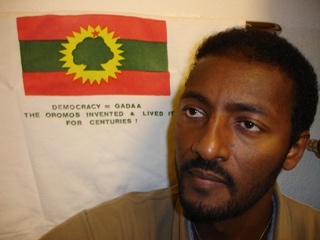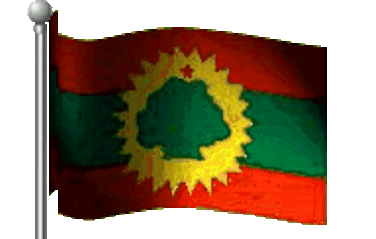In Ethiopia's Ogaden desert, horrors of a hidden war

IN THE OGADEN DESERT, Ethiopia: The rebels march 300 strong across the crunchy earth, young men with dreadlocks and AK-47s slung over their shoulders.
New York Times Video Report on ONLF - Ogaden Somali Fighters
Often when they pass through a village, the entire village lines up, one sunken cheekbone to the next, to squint at them.
“May Allah bring you victory,” one woman whispered.
This is the Ogaden, a corner of Ethiopia that the urbane officials in Addis Ababa, the capital, would rather outsiders never see. It is the epicenter of a separatist war in which impoverished nomads are fighting one of the biggest armies in Africa.
What goes on here seems to be starkly different from the carefully-constructed image that Ethiopia - a country that America increasingly relies on to fight militant Islam in the Horn of Africa - tries to project.
In village after village, people said they had been brutalized by government troops. They described a widespread and longstanding reign of terror, with Ethiopian soldiers gang-raping women, burning down huts and killing civilians at will.
It is the same military that the American government helps train and equip - and provides with prized intelligence. The two nations have been allies for years, but recently they have grown especially close, teaming up last winter to oust an Islamic movement that controlled much of Somalia and rid the region of a potential terrorist threat.
The Bush administration, particularly the military, considers Ethiopia its best bet in the Horn of Africa - which, with Sudan, Somalia and Eritrea, is fast becoming intensely violent, virulently anti-American and an incubator for terrorism.
But an emerging concern for American officials is the way the Ethiopian military operates inside its own borders, especially in war zones like the Ogaden.
Anab, a 40-year-old camel herder who was too frightened, like many others, to give her last name, said soldiers had taken her to a police station, put her in a cell and twisted her nipples with pliers. She said government security forces routinely rounded up young women under the pretext that they were rebel supporters so they could bring them to jail and rape them.
“Me, I am old,” she said, “but they raped me, too.”
Moualin, a rheumy-eyed elder, said Ethiopian troops had stormed his village, Sasabene, in January looking for rebels and burned much of it down.
“They hit us in the face with the hardest part of their guns,” he said.
The villagers said the abuses have intensified since April, when the rebels attacked a Chinese-run oil field, killing 9 Chinese workers and more than 60 Ethiopian soldiers and staff. The Ethiopian government has vowed to crush the rebels but rejects all claims that it abuses civilians.
“Our soldiers are not allowed to do these kinds of things,” said a government spokesman, Nur Abdi Mohammed. “This is only propaganda and cannot be justified. If a government soldier did this type of thing they would be brought before the courts.”
Even so, the State Department, the European Parliament, and many human rights groups, mostly outside of Ethiopia, have cited thousands of cases of torture, arbitrary detention and extrajudicial killings - enough to raise questions in Congress about American support of the Ethiopian government.
“This is a country that is abusing its own people and has no respect for democracy,” said Representative Donald Payne, chairman of the House subcommittee on Africa and global health.
“We’ve not only looked the other way but we’ve pushed them to intrude in other sovereign nations,” he added, referring to the satellite images and other strategic help the American military gave Ethiopia in December, when thousands of Ethiopian troops poured into Somalia and overthrew the Islamist regime.
According to Georgette Gagnon, deputy director for the Africa division of Human Rights Watch, Ethiopia is one of the most repressive countries in Africa.
“What the Ethiopian security forces are doing,” she said, “may amount to crimes against humanity.”
Human Rights Watch issued a report in 2005 that described a rampage by government troops against members of the Anuak minority tribe in western Ethiopia, in which soldiers ransacked homes, beat villagers to death with iron bars and in one case, according to a witness, tied up a prisoner and ran over him with a military truck.
After the report came out, the researcher who wrote it was banned by the Ethiopian government from returning to the country. Similarly, three New York Times journalists who visited the Ogaden to cover this story were imprisoned for five days and had all their equipment confiscated before being released without charges.
In many ways, Ethiopia has a lot going for it these days: new buildings, new roads, low crime and a booming trade in cut flowers and coffee. It is the second most populous country in sub-Saharan Africa, behind Nigeria, with 77 million people.
Its leaders, many whom were once rebels themselves, from a neglected patch of northern Ethiopia, are widely known as some of the most savvy officials on the continent. They had promised to let some air into a stultified political system during the national elections of 2005, which were billed as a milestone on the road to democracy.
But with the opposition poised to win a record-number of seats in Parliament, the government cracked down brutally, opening fire on demonstrators, rounding up tens of thousands of opposition supporters and students and leveling charges of treason and even attempted genocide against top opposition leaders, including the man elected mayor of Addis Ababa.
Many opposition members are now in jail or in exile. The rest seem demoralized.
“There are no real steps toward democracy,” said Merera Gudina, vice president of the United Ethiopian Democratic Forces, a leading opposition party. “No real steps toward opening up space, no real steps toward ending repression.”
Ethiopian officials have routinely dismissed such complaints, accusing political protesters of stoking civil unrest.
Ethiopia has always had an authoritarian streak. This is a country, after all, whose rulers, up until the 1970s, were considered direct descendants of King Solomon. It is big, poor, famine-stricken, about half-Christian and half-Muslim, surrounded by hostile enemies and full of heavily armed separatist factions.
As one high-ranking Ethiopian official put it, “This country has never been easy to rule.”
That has certainly been true for the Ogaden desert, a huge, dagger-shaped chunk of territory between the highlands of Ethiopia and the border of Somalia. The people here are mostly ethnic Somalis and they have been chaffing against Ethiopian rule since 1897, when the British ceded their claims to the area.
The colonial officials did not think the Ogaden was worth much. They saw thorny hills and thirsty people. Even today, it is still like that. What passes for a town is a huddle of bubble-shaped huts, the movable homes of camel-thwacking nomads who somehow survive out here. For roads, picture Tonka truck tracks running through a sandbox. The primary elements in this world are skin and bone and sun and rock. And guns. Loads of them.
Camel herders carry rifles to protect their animals. Young women carry pistols to protect their bodies. And then there is the Ogaden National Liberation Front, the machine-gun-toting rebels fighting for control of this desiccated wasteland.
Lion. Radio. Fearless. Peacock. Most of the men have nicknames that conceal their real identities. Peacock, who spoke some English, served as a guide. He shared the bitter little plums the soldiers pick from thorn bushes - “Ogaden chocolate,” he called them. He showed the way to gently skim water from the top of a mud puddle to minimize the amount of dirt that ends up in your stomach - even in the rainy season this is all there is to drink.
He pointed out the anthills, the coming storm clouds, the especially ruthless thorn trees and even a graveyard that stood incongruously in the middle of the desert. The graves - crude pyramids of stones - were from the war in 1977-78, when Somalia tried, disastrously, to pry the Ogaden out of Ethiopia’s hands and lost thousands of men. “It’s up to us now,” Peacock said.
Peacock was typical of the rebels. He was driven by anger. He said Ethiopian soldiers had hanged his mother, raped his sister and beaten his father. “I know, it’s hard to believe,” he said. “But it’s true.”
He had the hunch of a broken man and a voice that seemed far too tired for his 28 years. “It’s not that I like living in the bush,” he said. “But I have nowhere else to go.”
The armed resistance began in 1994, after the Ogaden National Liberation Front, then a political organization, broached the idea of splitting off from Ethiopia. The central government responded by imprisoning Ogadeni leaders, and according to academics and human rights groups, assassinating others. The Ogaden is part of the Somali National Regional State, one of nine ethnic-based states within Ethiopia’s unusual ethnic-based federal system.
On paper, all states have the right to secede, if they follow the proper procedures. But the government feared that if the Somalis broke away, so too would the Oromos, the Afar and many other ethnic groups pining for a country of their own.
The Ethiopian government calls the Ogaden rebels terrorists and says they are armed and trained by Eritrea, Ethiopia’s neighbor and bitter enemy. One of the reasons Ethiopia decided to invade Somalia was to prevent the rebels from using it as a base.
The government blames them for a string of recent bombings and assassinations and says they often target rival clan members. Ethiopian officials have been pressuring the State Department to add the Ogaden National Liberation Front to its list of designated foreign terrorist organizations. Until recently, American officials refused, saying the rebels had not threatened civilians or American interests.
“But after the oil field attack in April,” said one American official who spoke on the condition of anonymity, “we are reassessing that.”
American policy toward Ethiopia seems to be in flux. Administration officials are trying to boost the amount of nonhumanitarian aid to Ethiopia to $481 million next year, from $284 million this year. But key Democrats in Congress, including Payne, are questioning this, saying that because of Ethiopia’s human rights record, it is time to stop writing the country a blank check.
In the Ogaden, it is not clear how many people are dying. The vast area is essentially a no-go zone for most human rights workers and journalists and where the Ethiopian military, by its own admission, is waging an intense counterinsurgency campaign.
The violence has been particularly acute against women, villagers said, and many have recently fled.
Asma, 19, who now lives in neighboring Somaliland, said she was stuck in an underground cell for more than six months last year, raped and tortured. “They beat me on the feet and breasts,” she said. She was freed only after her father paid the soldiers ransom, she said, though she did not know how much.
Ambaro, 25, now living in Addis Ababa, said she was gang-raped by five Ethiopian soldiers in January near the town of Fik. She said that troops came to her village every night to pluck another young woman.
“I’m in pain now, all over my body,” she said. “I’m worried that I’ll become crazy because of what happened.”
Many Ogaden villagers said that when they had tried to bring up abuses with clan chiefs or the local authorities, they were told it was better to keep quiet.



0 Comments:
Post a Comment
<< Home